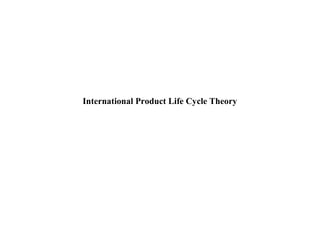
Ibm iplc theory
- 1. International Product Life Cycle Theory
- 2. The international product life cycle (IPL) is a conceptual model which briefs how a company evolves over time and across national borders. This theory shows the development of a company’s marketing program on both domestic and foreign platforms. International product lifecycle includes economic principles and standards like market development and economies of scale, with product lifecycle marketing and other standard business models.
- 3. The four key elements of the international product lifecycle theory are • The layout of the demand for the product • Manufacturing the product • Competitions in international market • Marketing strategy
- 4. • According to Raymond Vernon there are four stages in a product’s life cycle: • Introduction • Growth • Maturity • Decline • The length of a Product Life Cycle stage varies for different products, one stage may last some weeks while others even last decades. The life span of a product and how fast it goes through the entire cycle depends on for instance market demand and how marketing instruments are used.
- 5. The Introduction Stage • When an organization has developed a product successfully, it will be introduced into the national (and international) outlet. In order to create demand, investments are made with respect to consumer awareness and promotion of the new product in order to get sales going. At this stage, profits are low and there are only few competitors. When more items of the product are sold, it will enter the next stage automatically. • Competition at international level is absent during the introduction stage of the international product lifecycle. Competition comes into picture during the growth stage, when developed markets start copying the product and sell it in the domestic market. These competitors may also transform from being importers to exporters to the same country that once introduced the product.
- 6. The Growth Stage • In this stage of PLC,the demand for the product increases sales. As a result, the production costs decrease and high profits are generated. The product becomes widely known, and competitors will enter the market with their own version of the product. Usually, they offer the product at a much lower sales price. To attract as many consumers as possible, the company that developed the original product will still increase its promotional spending. When many potential new customers have bought the product, it will enter the next stage.
- 7. The Maturity Stage • In the maturity phase of the product life cycle, demand levels off and sales volume increases at a slower rate.The original supplier may reduce prices to maintain market share and support sales. Profit margins decrease, but the business remains attractive because volume is high and costs, such as those related to development and promotion, are also lower. • Duplicate products are reported in foreign markets marking a decline in export sales.
- 8. The Decline Stage • This is the final stage of the product lifecycle. In this stage sales volumes decrease and many such products are removed or their usage is discontinued. • The follower economies have developed imitations as good as the original product and are able to export them to the original supplier's home market, further depressing sales and prices. The original supplier can no longer produce the product competitively but can generate some return by cleaning out inventory and selling the remaining products at discontinued- items prices.
- 9. It is a myth that every product has to go through each of the stages of the product life cycle. There are products that never get beyond the introduction stage, whereas other products remain in the maturity stage for a considerable length of time.
- 10. For example, the PHILIPS light bulb was a product that found itself in the maturity stage for decades. The duration of each stage depends on demand, production costs and revenues. Low production costs and a high demand will ensure a longer product life. When production costs are high and there is a low demand for the product, it will not be offered on the market for a long time and, eventually, it will be withdrawn from the market via the decline stage.